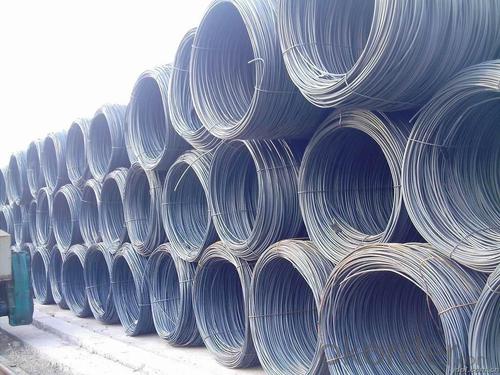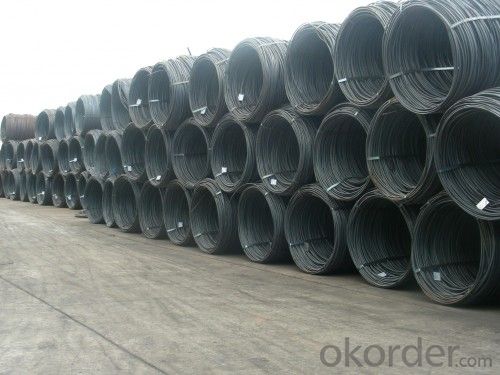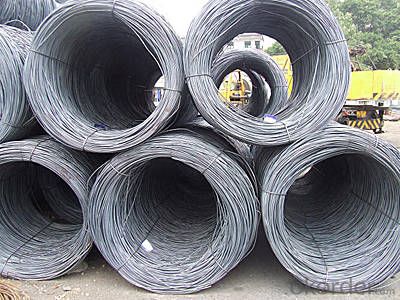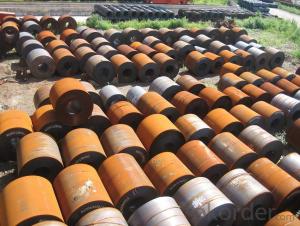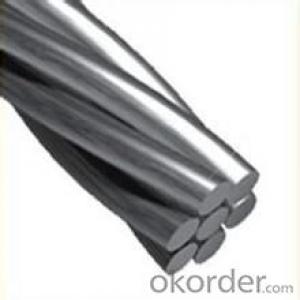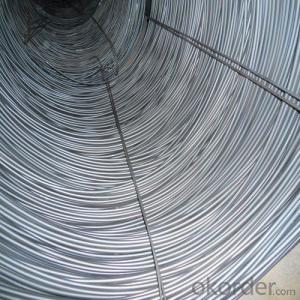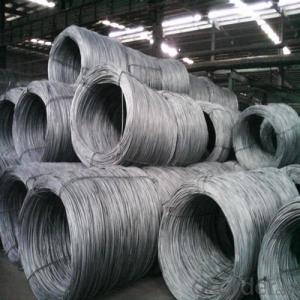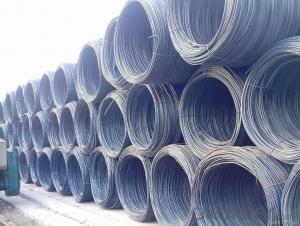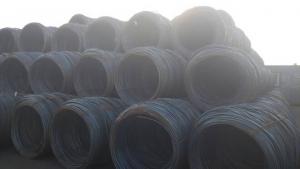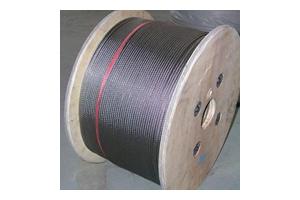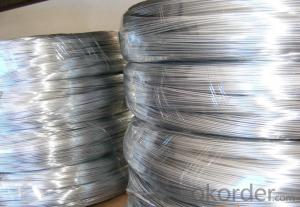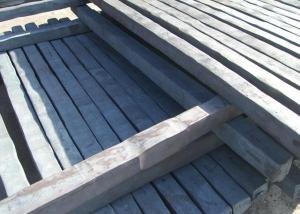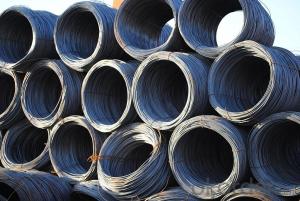Steel Wire Rod with Good Price in Different Materials
- Loading Port:
- Tianjin
- Payment Terms:
- TT or LC
- Min Order Qty:
- 30 m.t.
- Supply Capability:
- 20000 m.t./month
OKorder Service Pledge
OKorder Financial Service
You Might Also Like
Product Description of Steel Wire Rod with Good Price in Different Materials:
OKorder is offeringSteel Wire Rod with Good Price in Different Materials at great prices with worldwide shipping. Our supplier is a world-class manufacturer of steel, with our products utilized the world over. OKorder annually supplies products to African, South American and Asian markets. We provide quotations within 24 hours of receiving an inquiry and guarantee competitive prices.
Product Applications of Steel Wire Rod with Good Price in Different Materials:
Steel Wire Rod with Good Price in Different Materials are ideal for structural applications and are widely used in construction and manufacturing. Carbon steel wire rod is mainly used for reinforcement of reinforced concrete and welded structure or reprocessed (roberts , nail, etc.) materials, especially used to produce wire drawing, welding electrode, nails, spring, electronic, precise machinery parts and so on.
Product Advantages of Steel Wire Rod with Good Price in Different Materials:
OKorder's Steel Wire Rod with Good Price in Different Materials are durable, strong, and wide variety of sizes. They are newly produced by good quality steel billets.
Main Product Features of Steel Wire Rod with Good Price in Different Materials:
· Premium quality
· Prompt delivery & seaworthy packing (30 days after receiving deposit)
· Can be recycled and reused
· Mill test certification
· Professional Service
· Competitive pricing
Product Specifications of Steel Wire Rod with Good Price in Different Materials:
Steel Grade: SAE1006-1018B
Standard: ASTM, GB
Diameter: 5.5mm, 6.5mm, 7mm,8mm,9mm,10mm,12mm,14mm
Type: in coil, coil weight around 2MT
Alloy or Not: Alloy
Technique: Hot Rolled
Place of Origin: China Mainland
Surface: round, no twisted, light and smooth
FAQ of Steel Wire Rod with Good Price in Different Materials:
Q1: Why buy Hot Rolled Low Carbon Steel Wire Rods for Nails, Steel Wire Mesh from OKorder.com?
A1: All products offered byOKorder.com are carefully selected from China's most reliable manufacturing enterprises. Through its ISO certifications, OKorder.com adheres to the highest standards and a commitment to supply chain safety and customer satisfaction.
Q2: How do we guarantee the quality of our products?
A2: We have established an advanced quality management system which conducts strict quality tests at every step, from raw materials to the final product. At the same time, we provide extensive follow-up service assurances as required.
Q3: How soon can we receive the product after purchase?
A3: Within three days of placing an order, we will arrange production. The normal sizes with the normal grade can be produced within one month. The specific shipping date is dependent upon international and government factors, the delivery to international main port about 45-60days.
Pictures of Steel Wire Rod with Good Price in Different Materials
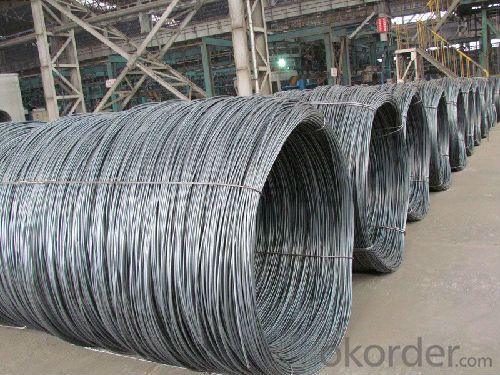
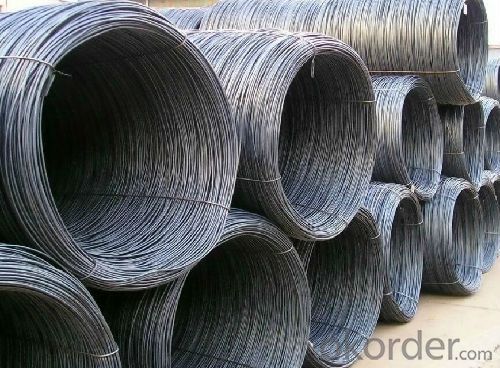
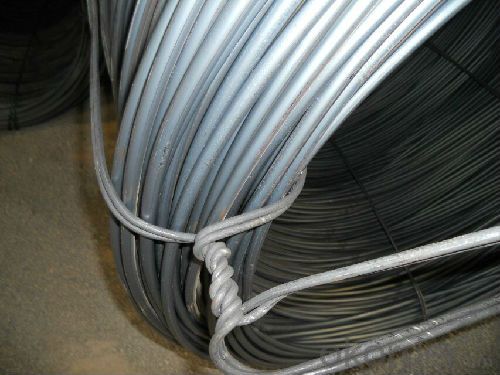
- Q: What are the main factors influencing the choice of steel wire rod order quantity?
- The main factors influencing the choice of steel wire rod order quantity include demand forecasting, production capacity, inventory management, cost considerations, and supplier relationships.
- Q: How is steel wire rod used in the manufacturing of wire for musical instruments?
- Steel wire rod is an essential component in the manufacturing of wire for musical instruments. It serves as the raw material that is drawn and shaped to create thin, high-quality wires used in various instruments such as guitars, pianos, and violins. The steel wire rod's strength and durability make it ideal for producing strings with excellent sound clarity and resonance. Additionally, its flexibility allows for precise tuning and responsiveness, ensuring the instrument produces the desired musical tones.
- Q: How is the elongation of steel wire rod determined?
- The elongation of a steel wire rod is determined by measuring the change in length of the wire when subjected to a tensile force. This can be achieved by clamping the wire at both ends, applying a known force, and then measuring the increase in length using a device called an extensometer. The elongation is calculated by dividing the change in length by the original length of the wire and multiplying it by 100 to express it as a percentage.
- Q: How is steel wire rod used in the production of wire strands for suspension bridges?
- Steel wire rod is used as the raw material in the production of wire strands for suspension bridges. The wire rod is first processed through various mechanical and heat treatments to enhance its strength and durability. Then, multiple wire rods are twisted together to form a wire strand, which is a critical component of suspension bridge cables. These wire strands are capable of supporting heavy loads and providing stability to the bridge structure, making them essential for the construction of suspension bridges.
- Q: How is steel wire rod used in the manufacturing of suspension components for automobiles?
- Due to its superior strength and durability, steel wire rod is widely utilized in the production of suspension components for automobiles. These essential components, including coil springs, torsion bars, and stabilizer bars, are responsible for providing stability, control, and comfort to the vehicle's ride. Coil springs, a crucial part of the suspension system, are manufactured using steel wire rods. Designed to absorb shocks and vibrations from the road, coil springs ensure a smooth and comfortable ride for passengers. The steel wire rod is typically shaped into a helical form and possesses high tensile strength, enabling it to withstand the compression and extension forces exerted on it. Another type of suspension component utilizing steel wire rod is the torsion bar. These bars resist the twisting motion of the suspension system, promoting stability and preventing excessive body roll during cornering. Torsion bars made from steel wire rods with specific properties, such as high yield strength and torsional rigidity, are able to withstand the required torque and stress. Stabilizer bars, also known as sway bars or anti-roll bars, are commonly employed in suspension systems to reduce body roll during cornering. These bars are constructed using steel wire rods with specific diameters and stiffness. By forming the steel wire rod into a tubular shape, the stabilizer bar can effectively resist the twisting forces encountered when the vehicle turns. The high strength of the steel wire rod ensures that the stabilizer bar can efficiently transfer forces from one side of the suspension system to the other, minimizing body roll and enhancing vehicle stability. To recapitulate, steel wire rod plays a vital role in the manufacturing of suspension components for automobiles. Its exceptional strength, durability, and resistance to various forces make it an ideal material for coil springs, torsion bars, and stabilizer bars. By incorporating steel wire rods in the production of suspension components, automotive manufacturers can guarantee the performance, safety, and comfort of their vehicles.
- Q: How does the corrosion resistance of steel wire rod vary with different coatings?
- The corrosion resistance of steel wire rod can vary significantly with different coatings. Coatings such as zinc, galvanized, or epoxy can provide a protective barrier against moisture and corrosive elements, thereby enhancing the lifespan and durability of the wire rod. The choice of coating depends on the specific application and the environmental conditions the wire rod will be exposed to.
- Q: What are the different surface inspection methods for steel wire rod?
- There are several different surface inspection methods that can be used for steel wire rod. These methods are employed to ensure the quality and integrity of the surface of the wire rod. 1. Visual Inspection: This is the simplest and most basic method of surface inspection. It involves visually inspecting the surface of the wire rod for any visible defects such as scratches, dents, or corrosion. 2. Magnetic Particle Inspection: This method involves applying a magnetic field to the wire rod and then applying a magnetic particle solution on the surface. Any defects or cracks in the surface will cause the particles to cluster and become visible under UV light. 3. Eddy Current Testing: This non-destructive testing method involves inducing an electric current in the wire rod and measuring the resulting electromagnetic field. Any variations or anomalies in the electromagnetic field can indicate surface defects. 4. Ultrasonic Testing: This method uses high-frequency sound waves to penetrate the surface of the wire rod. The sound waves are reflected back when they encounter any surface defects or cracks, allowing for their detection. 5. Dye Penetrant Inspection: This method involves applying a liquid dye to the surface of the wire rod. The dye is then allowed to seep into any surface defects or cracks. After a certain period of time, the excess dye is removed, and a developer is applied to make the defects visible. 6. Laser Scanning: This advanced method utilizes laser technology to scan the surface of the wire rod. The laser detects any deviations from the normal surface profile, such as dents or scratches, and provides a detailed analysis of the surface condition. 7. X-ray Inspection: This method is used to inspect the internal and external surface of the wire rod. X-rays are passed through the wire rod, and any defects or anomalies are detected by the variations in the intensity of the X-ray beam. Each of these surface inspection methods has its own advantages and limitations. The choice of method depends on the specific requirements, the type of defects to be detected, and the level of accuracy needed for the inspection.
- Q: How is steel wire rod cooled after the rolling process?
- Steel wire rod undergoes various cooling methods after the rolling process to achieve desired properties and prevent distortion or damage. Air cooling is a common method where hot wire rods are gradually cooled by exposure to ambient air. This allows for controlled cooling and uniform temperature distribution. Another method is water cooling, which involves spraying or immersing the wire rods in water. Water cooling is faster and more efficient due to its superior heat transfer properties. It results in improved mechanical properties and surface quality. In certain cases, accelerated cooling is utilized using specialized cooling beds or water sprays. This method involves forcefully reducing the wire rod's temperature by applying cool air or water onto its surface. Accelerated cooling is particularly beneficial for achieving specific mechanical properties or enhancing the wire rod's microstructure. Controlled cooling processes are also employed, such as controlled cooling in a furnace or cooling in a quenching tank. These methods involve placing the wire rods in a controlled environment, like a furnace with a controlled atmosphere or a quenching tank filled with a specific cooling medium. These controlled cooling processes enable precise temperature and cooling rate control, resulting in the desired material properties and microstructure. Ultimately, the cooling process after the rolling of steel wire rods significantly impacts their final properties and quality. The choice of cooling method depends on factors such as the desired properties, production capacity, and available resources.
- Q: How is steel wire rod used in the manufacturing of wire for elevator door systems?
- Steel wire rod is an essential component in the manufacturing of wire for elevator door systems. It serves as the raw material that is processed and drawn into thinner wires, which are then used to create the intricate cables and ropes that operate elevator doors. The high strength and durability of steel wire rod ensure that the wires can withstand the tension and stress involved in elevator door operations, providing a reliable and safe mechanism for opening and closing elevator doors.
- Q: How is steel wire rod used in the production of wire mesh for industrial filtration systems?
- Steel wire rod is used in the production of wire mesh for industrial filtration systems as it serves as the primary material for manufacturing the mesh. The wire rod is first drawn through a series of dies to reduce its diameter and increase its length. This process, known as wire drawing, results in a thin and continuous wire that is then woven or welded to form a mesh structure. The strength and durability of steel wire make it ideal for withstanding the high pressures and harsh operating conditions encountered in industrial filtration systems. Additionally, the uniformity and precision of the wire rod ensure the production of a consistent and reliable wire mesh product.
Send your message to us
Steel Wire Rod with Good Price in Different Materials
- Loading Port:
- Tianjin
- Payment Terms:
- TT or LC
- Min Order Qty:
- 30 m.t.
- Supply Capability:
- 20000 m.t./month
OKorder Service Pledge
OKorder Financial Service
Similar products
Hot products
Hot Searches
Related keywords



